On-Chip Group-IV Heisenberg-Limited Sagnac Interferometric Gyroscope at Room Temperature
Abstract
1. Introduction
2. Quantum Photonics Perspective
3. Quantum Photonics for Rotation Sensing
4. Numerical Results
4.1. Device Overview
4.2. Nonlinear Source and State Preparation
4.3. Quantum Interferometer and Coincidence Measurements
5. Conclusions
Supplementary Materials
Author Contributions
Funding
Conflicts of Interest
References
- Soref, R.A.; De Leonardis, F.; Passaro, V.M.N. Simulations of Nanoscale Room-Temperature Waveguide-Coupled Single-Photon Avalanche Detectors for Silicon Photonic Sensing and Quantum Applications. ACS Appl. Nano Mater. 2019, 2, 7503–7512. [Google Scholar] [CrossRef]
- Harris, N.C.; Steinbrecher, G.R.; Prabhu, M.; Lahini, Y.; Mower, J.; Bunandar, D.; Chen, C.; Wong, F.N.C.; Baehr-Jones, T.; Hochberg, M.; et al. Quantum transport simulations in a programmable nanophotonic processor. Nat. Photonics. 2017, 11, 447–452. [Google Scholar] [CrossRef]
- Qiang, X.; Zhou, X.; Wang, J.; Wilkes, C.M.; Loke, T.; O’Gara, S.; Kling, L.; Marshall, G.D.; Santagati, R.; Ralph, T.C.; et al. Large-scale silicon quantum photonics implementing arbitrary two-qubit processing. Nat. Photonics. 2018, 12, 534–539. [Google Scholar] [CrossRef]
- Carolan, J.; Harrold, C.; Sparrow, C.; Martin-Lopez, E.; Russell, N.J.; Silverstone, J.W.; Shadbolt, P.J.; Matsuda, N.; Oguma, M.; Itoh, M.; et al. Universal linear optics. Science 2015, 349, 711–716. [Google Scholar] [CrossRef]
- Paesani, S.; Ding, Y.; Santagati, R.; Chakhmakhchyan, L.; Vigliar, C.; Rottwitt, K.; Oxenløwe, L.K.; Wang, J.; Thompson, M.G.; Laing, A. Generation and sampling of quantum states of light in a silicon chip. Nat. Phys. 2019, 15, 925–929. [Google Scholar] [CrossRef]
- Spring, J.B.; Metcalf, B.J.; Humphreys, P.C.; Kolthammer, W.S.; Jin, X.-M.; Barbieri, M.; Datta, A.; Thomas-Peter, N.; Langford, N.K.; Kundys, D.; et al. Boson sampling on a photonic chip. Science 2013, 339, 798–801. [Google Scholar] [CrossRef]
- Sibson, P.; Erven, C.; Godfrey, M.; Miki, S.; Yamashita, T.; Fujiwara, M.; Sasaki, M.; Terai, H.; Tanner, M.G.; Natarajan, C.M.; et al. Chip-based quantum key distribution. Nat. Commun. 2017, 8, 13984. [Google Scholar] [CrossRef]
- Bunandar, D.; Lentine, A.; Lee, C.; Cai, H.; Long, C.M.; Boynton, N.; Martinez, N.; DeRose, C.; Chen, C.; Grein, M.; et al. Metropolitan quantum key distribution with silicon photonics. Phys. Rev. 2018, 8, 021009. [Google Scholar] [CrossRef]
- Ma, C.; Sacher, W.D.; Tang, Z.; Mikkelsen, J.C.; Yang, Y.; Xu, F.; Thiessen, T.; Lo, H.-K.; Poon, J.K.S. Silicon photonic transmitter for polarization-encoded quantum key distribution. Optica 2016, 3, 1274–1278. [Google Scholar] [CrossRef]
- Sibson, P.; Kennard, J.E.; Stanisic, S.; Erven, C.; O’Brien, J.L.; Thompson, M.G. Integrated silicon photonics for high-speed quantum key distribution. Optica 2017, 4, 172–177. [Google Scholar] [CrossRef]
- Zhang, G.; Haw, J.Y.; Cai, H.; Xu, F.; Assad, S.M.; Fitzsimons, J.F.; Zhou, X.; Zhang, Y.; Yu, S.; Wu, J.; et al. An integrated silicon photonic chip platform for continuous variable quantum key distribution. Nat. Photonics. 2019, 13, 839–842. [Google Scholar] [CrossRef]
- Jouguet, P.; Kunz-Jacques, S.; Leverrier, A.; Grangier, P.; Diamanti, E. Experimental demonstration of long distance continuous-variable quantum key distribution. Nat. Photonics. 2013, 7, 378. [Google Scholar] [CrossRef]
- Persechino, M.; Vidarte, L.T.; Ziebell, M.; Crozat, P.; Villing, A.; Marris-Morini, D.; Vivien, L.; Diamanti, E.; Grangier, P. Correlations with on chip-detection for continuous-variable QKD. In Proceedings of the 8th International Conference on Quantum Cryptography, Shanghai, China, 27–31 August 2018. [Google Scholar]
- Bozzio, M.; Orieux, A.; Trigo Vidarte, L.; Zaquine, I.; Kerenidis, I.; Diamanti, E. Experimental investigation of practical unforgeable quantum money. npj Quantum Inf. 2018, 4, 5. [Google Scholar] [CrossRef]
- Unnikrishnan, A.; MacFarlane, I.J.; Yi, R.; Diamanti, E.; Markham, D.; Kerenidis, I. Anonymity for practical quantum networks. Phys. Rev. Lett. 2019, 122, 240501. [Google Scholar] [CrossRef] [PubMed]
- Kumar, N.; Kerenidis, I.; Diamanti, E. Experimental demonstration of quantum advantage for one-way communication complexity surpassing best-known classical protocol. Nat. Commun. 2019, 10, 4152. [Google Scholar] [CrossRef] [PubMed]
- Orieux, A.; Diamanti, E. Recent advances on integrated quantum communications. J. Opt. 2016, 18, 083002. [Google Scholar] [CrossRef]
- Silverstone, J.W.; Bonneau, D.; O’Brien, J.L.; Thompson, M.G. Silicon quantum photonics. IEEE J. Sel. Top. Quantum Electron. 2016, 22, 390–402. [Google Scholar] [CrossRef]
- Bogdanov, S.; Shalaginov, M.Y.; Boltasseva, A.; Shalaev, V.M. Material platforms for integrated quantum photonics. Opt. Mater. Express. 2017, 7, 111–132. [Google Scholar] [CrossRef]
- Harris, N.C.; Bunandar, D.; Pant, M.; Steinbrecher, G.R.; Mower, J.; Prabhu, M.; Baehr-Jones, T.; Hochberg, M.; Englund, D. Large scale quantum photonic circuits in silicon. Nanophotonics 2016, 5, 456–468. [Google Scholar] [CrossRef]
- Oser, D.; Tanzilli, S.; Mazeas, F.; Ramos, C.A.; Le Roux, X.; Sauder, G.; Xin Hua, X.; Alibart, O.; Vivien, L.; Cassan, E.; et al. High quality photonic entanglement out of a stand-alone silicon chip. npj Quantum Inf. 2020, 6, 31. [Google Scholar] [CrossRef]
- Yu, L.; Yuan, C.; Qi, R.; Huang, Y.; Zhang, W. Hybrid waveguide scheme for silicon-based quantum photonic circuits with quantum light sources. Phot. Research. 2020, 8, 235–245. [Google Scholar] [CrossRef]
- Silverstone, J.W.; Bonneau, D.; Ohira, K.; Suzuki, N.; Yoshida, H.; Iizuka, N.; Ezaki, M.; Natarajan, C.M.; Tanner, M.G.; Hadfield, R.H.; et al. On-chip quantum interference between silicon photon-pair sources. Nat. Photonics. 2014, 8, 104–108. [Google Scholar] [CrossRef]
- Faruque, I.I.; Sinclair, G.F.; Bonneau, D.; Rarity, J.G.; Thompson, M.G. On-chip quantum interference with heralded photons from two independent micro-ring resonator sources in silicon photonics. Opt. Express. 2018, 28, 20379–20395. [Google Scholar] [CrossRef] [PubMed]
- Llewellyn, D.; Ding, Y.; Faruque, I.I.; Paesani, S.; Bacco, D.; Santagati, R.; Qian, Y.; Li, Y.; Xiao, Y.; Huber, M.; et al. Chip-to-chip quantum teleportation and multi-photon entanglement in silicon. Nat. Physics. 2020, 16, 148–153. [Google Scholar] [CrossRef]
- Kumar, R.R.; Wang, Y.; Zhang, Y.; Tsang, H.K. Quantum States of Higher-order Whispering gallery modes in a Silicon Micro-disk Resonator. arXiv 2020, arXiv:2003.06775. [Google Scholar] [CrossRef]
- Sagnac, G. The demonstration of the luminiferous aether by the interferometer in uniform rotation. CR Acad. Sci. 1913, 157, 708–710. [Google Scholar]
- Malykin, G.B. The Sagnac effect: Correct and incorrect explanations. Phys. Usp. 2000, 43, 1229–1252. [Google Scholar] [CrossRef]
- Wang, X.; Zhang, C.; Jin, J.; Song, N. Optimum length of fiber coil in space-borne interferometric fiber optic gyroscope. In Advances in Electric and Electronics (Lecture Notes in Electrical Engineering); Hu, W., Ed.; Springer: Berlin/Heidelberg, Germany, 2012; pp. 683–688. [Google Scholar]
- Sanders, S.J.; Strandjord, L.K.; Mead, D. Fiber optic gyro technology trends-a Honeywell perspective. In Proceedings of the 15th Optical Fiber Sensors Conference Technicalal Digest, Portland, OR, USA, 10 May 2002. [Google Scholar]
- Kajioka, H.; Kumagai, T.; Nakai, H.; Dohsho, T.; Soekawa, H.; Yuhara, T. Commercial applications of mass-produced fiber optic gyros. In Proceedings of the Fiber Optic Gyros: 20th Anniversary Conference, Denver, CO, USA, 12 November 1996. [Google Scholar]
- Smith, R.B.; Thompson, B.J. Selected Papers on Fiber Optic Gyro; SPIE: Washington, DC, USA, 1989. [Google Scholar]
- Passaro, V.M.N.; Cuccovillo, A.; Vaiani, L.; De Carlo, M.; Campanella, C.E. Gyroscope technology and applications: A review in the industrial perspective. Sensors 2017, 27, 2284. [Google Scholar] [CrossRef]
- De Carlo, M.; De Leonardis, F.; Passaro, V.M.N. Design Rules of a Microscale PT-Symmetric Optical Gyroscope Using Group IV Platform. J. Lightwave Technol. 2018, 36, 3261–3268. [Google Scholar] [CrossRef]
- De Carlo, M.; De Leonardis, F.; Lamberti, L.; Passaro, V. High-Sensitivity Real-Splitting Anti-PT-Symmetric Microscale Optical Gyroscope. Optics Lett. 2019, 44, 3956–3959. [Google Scholar] [CrossRef]
- Lai, Y.; Lu, Y.; Suh, M.; Yuan, Z.; Vahala, K. Observation of the Exceptional-Point-Enhanced Sagnac Effect. Nature 2019, 576, 65–69. [Google Scholar] [CrossRef] [PubMed]
- Hokmabadi, M.; Schumer, A.; Christodoulides, D.; Khajavikhan, M. Non-Hermitian Ring Laser Gyroscopes With Enhanced Sagnac Sensitivity. Nature 2019, 576, 70–74. [Google Scholar] [CrossRef] [PubMed]
- Dowling, J.P. Quantum optical metrology–The lowdown on high N00N states. Contemp. Phys. 2008, 49, 125–143. [Google Scholar] [CrossRef]
- Jacobson, J.; Björk, G.; Chuang, I.; Yamamoto, Y. Photonic de Broglie waves. Phys. Rev. Lett. 1995, 74, 4835–4838. [Google Scholar] [CrossRef]
- Kolkirian, A.; Agarwal, G.S. Heisenberg limited Sagnac interferometry. Opt. Express. 2007, 15, 6798–6808. [Google Scholar] [CrossRef]
- Fink, M.; Steinlechner, F.; Handsteiner, J.; Dowling, J.P.; Scheidl, T.; Ursin, R. Entanglement-enhanced optical gyroscope. New J. Phys 2019, 21, 053010. [Google Scholar] [CrossRef]
- Soref, R. Group IV photonics: Enabling 2 μm communications. Nat. Photon. 2015, 9, 358. [Google Scholar] [CrossRef]
- Wang, J.; Sciarrino, F.; Laing, A.; Thompson, M.G. Integrated photonic quantum technologies. Nat. Photon. 2020, 14, 273–284. [Google Scholar] [CrossRef]
- Krückel, C.J.; Fülöp, A.; Klintberg, T.; Bengtsson, J.; Andrekson, P.A.; Torres-Company, V. Linear and nonlinear characterization of low-stress high-confinement silicon-rich nitride waveguides. Opt. Express. 2015, 23, 25827–25837. [Google Scholar] [CrossRef]
- Wang, X.; Guan, X.; Gao, S.; Hu, H.; Oxenlowe, L.K.; Frandsen, L.H. Silicon/silicon-rich nitride hybrid-core waveguide for nonlinear optics. Opt. Express. 2019, 27, 23775–23784. [Google Scholar] [CrossRef]
- Tan, D.T.H.; Ooi, K.J.A.; Ng, D.K.T. Nonlinear optics on silicon-rich nitride-a high nonlinear figure of merit CMOS platform. Photon. Research. 2018, 6, B50–B66. [Google Scholar] [CrossRef]
- Selvaraja, S.K.; De Heyn, P.; Winroth, G.; Ong, P.; Lepage, G.; Cailler, C.; Rigny, A.; Bourdelle, K.K.; Bogaerts, W.; Van Thourhout, D.; et al. Highly uniform and low-loss passive silicon photonics devices using a 300mm CMOS platform. In Proceedings of the Optical Fiber Communication Conference 2014, San Francisco, CA, USA, 9–13 March 2014. [Google Scholar]
- Comsol Multiphysics. Single License; COMSOL Inc.: Stockholm, Sweden, 2005. [Google Scholar]
- Clemmen, S.; Phan Huy, K.; Bogaertz, W.; Baets, R.G.; Emplit, P.; Massar, S. Continuous wave photon pair generation in silicon-on-insulator waveguides and ring resonators. Opt. Express. 2009, 17, 16558–16570. [Google Scholar] [CrossRef] [PubMed]
- Mancinelli, M.; Trenti, A.; Piccione, S.; Fontana, G.; Dam, J.S.; Tidemand-Lichtenberg, P.; Pedersen, C.; Pavesi, L. Mid-infrared coincidence measurements on twin photons at room temperature. Nature Commun. 2017, 8, 15184. [Google Scholar] [CrossRef] [PubMed]
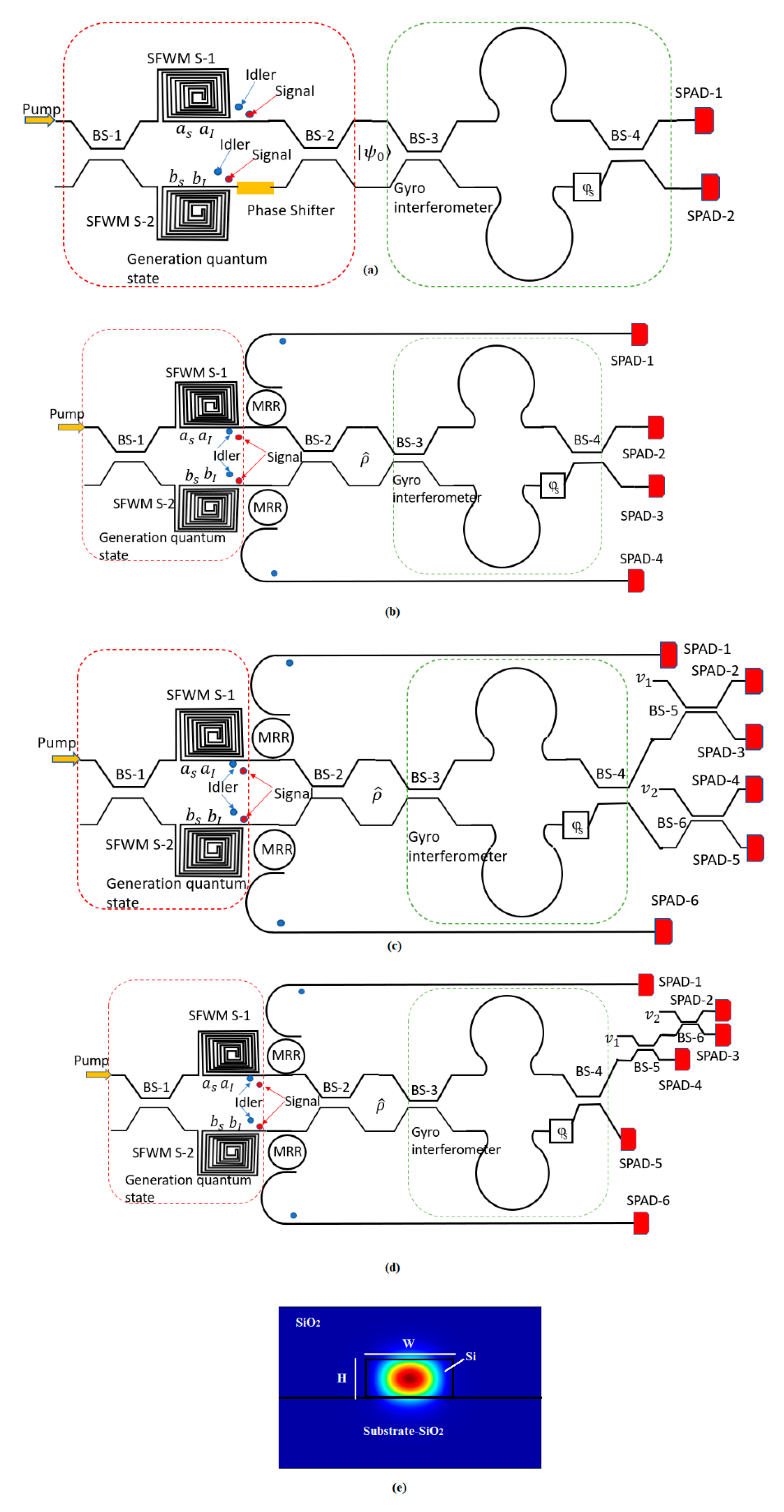
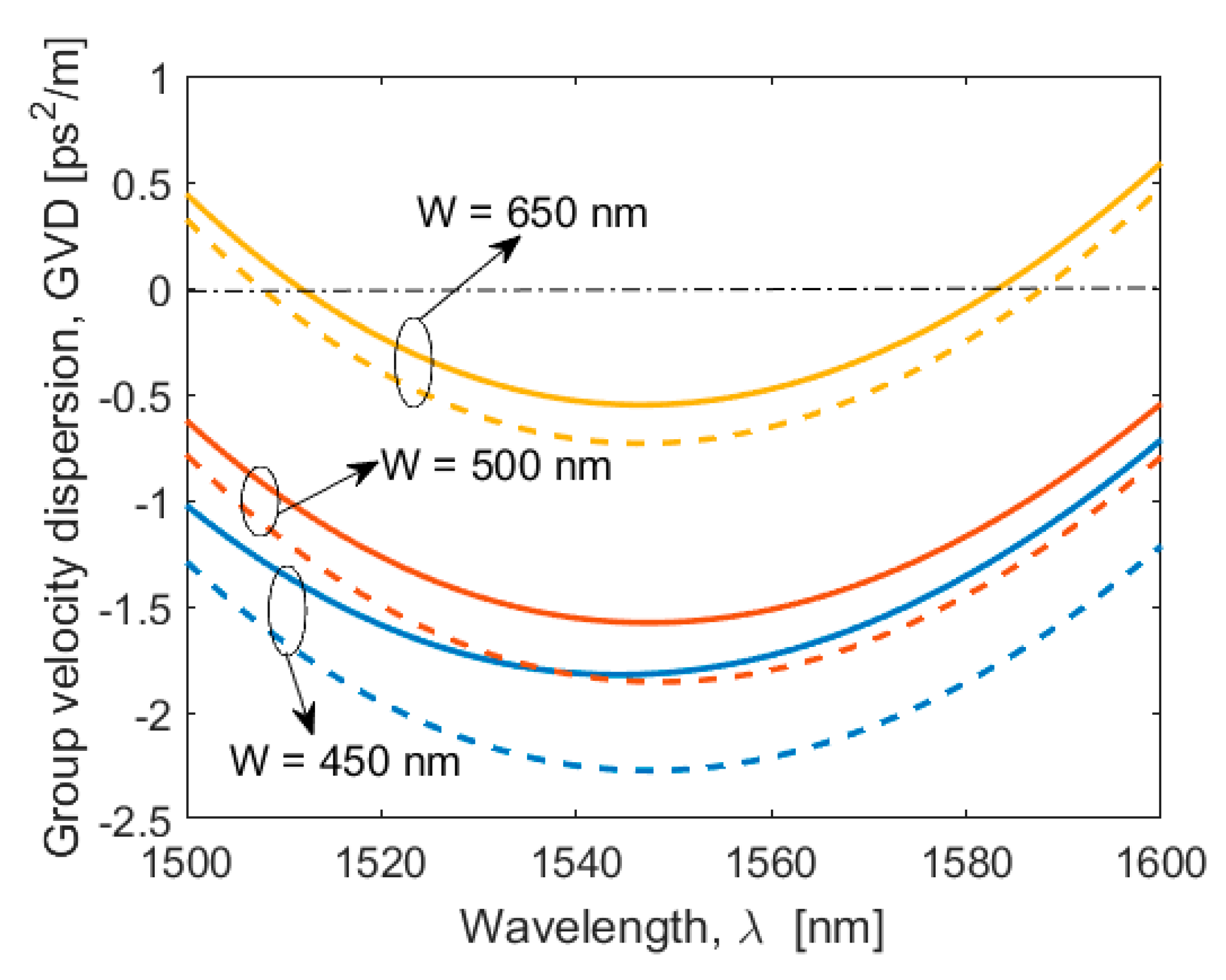
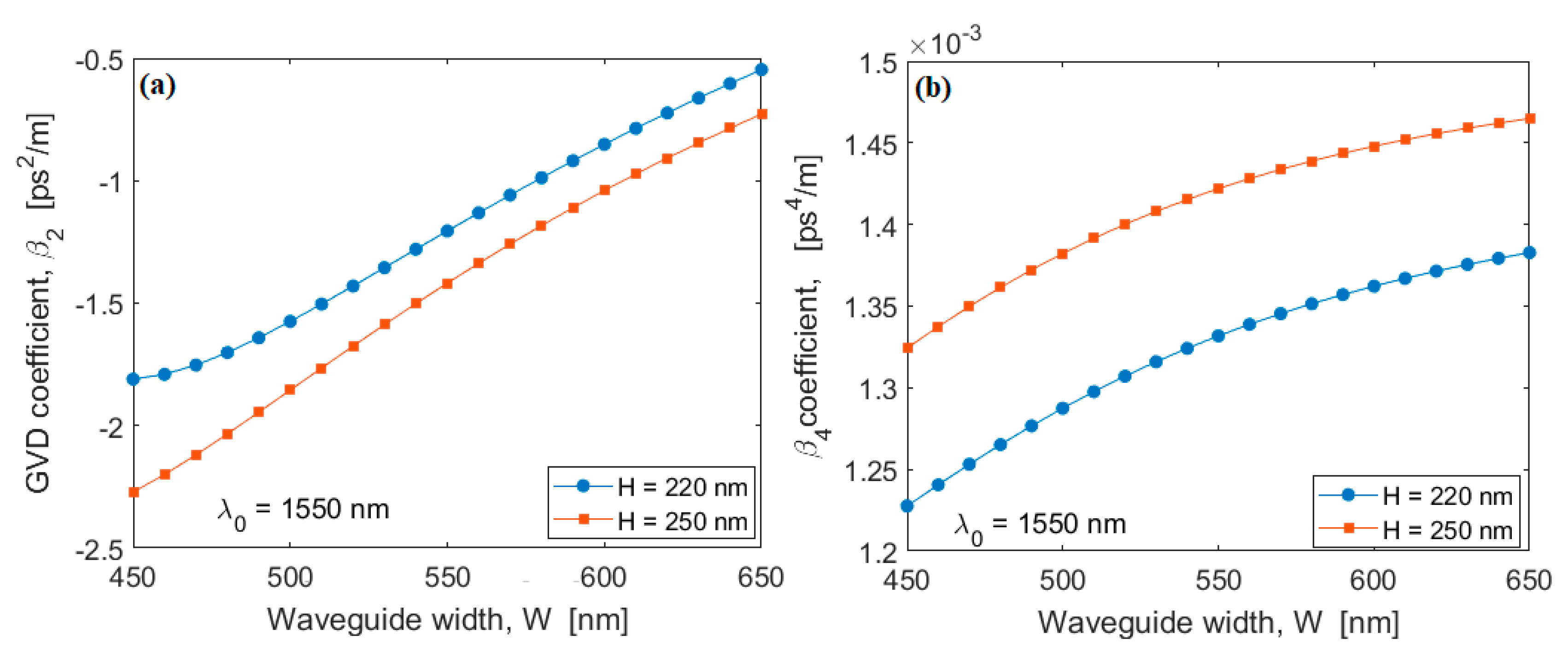
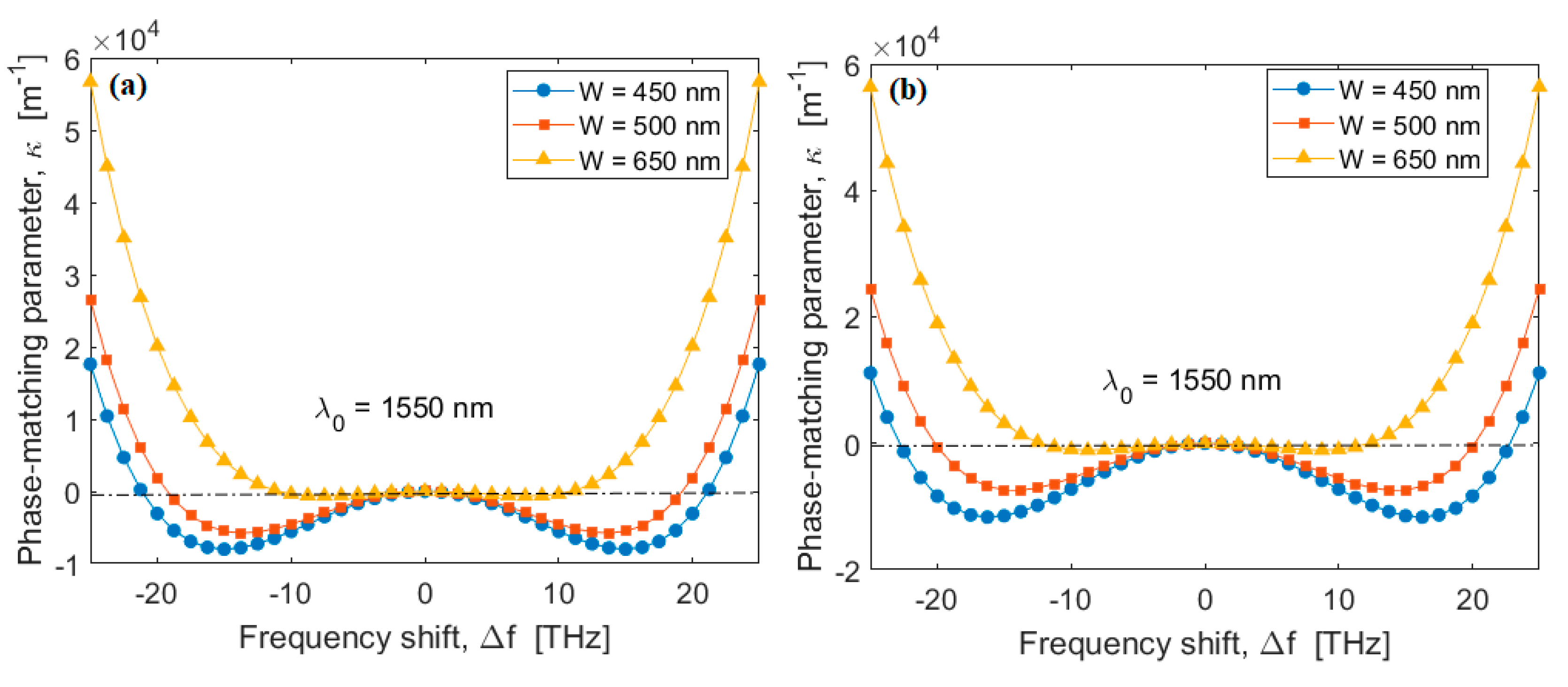

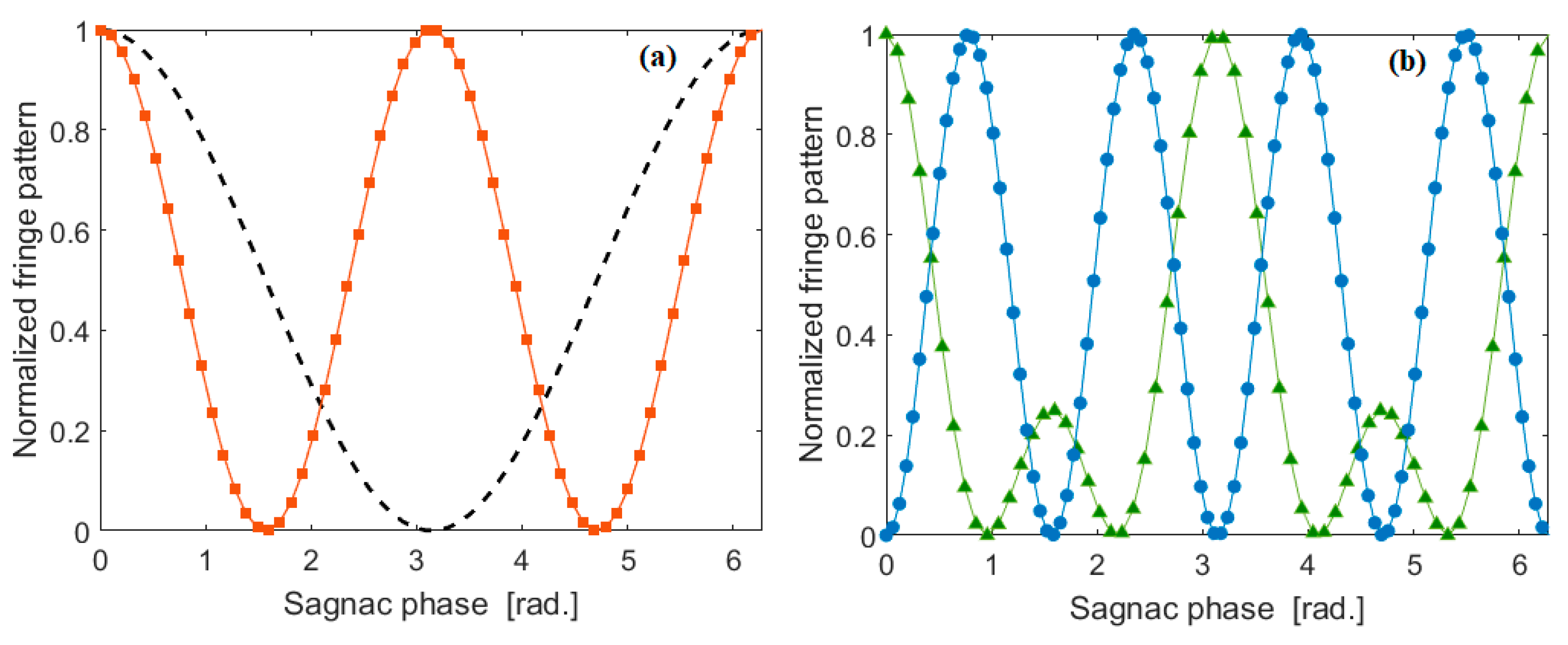
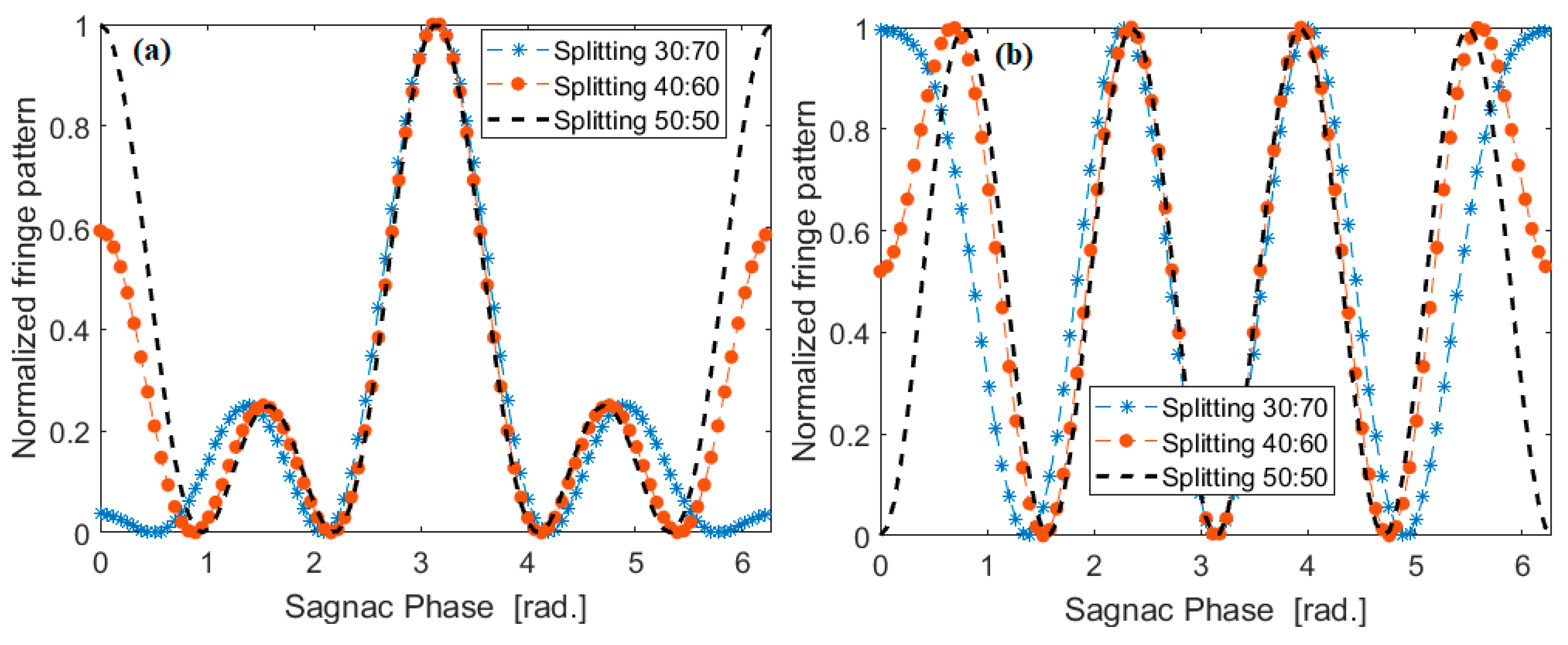
| Parameters | Si/SiO2 W = 500 nm; H = 220 nm | Si/SiO2 W = 500 nm; H = 250 nm | Si3N4/SiO2 W = 1060 nm; H = 600 nm | Si-enriched SiN/SiO2 W = 790 nm; H = 600 nm |
|---|---|---|---|---|
| [nm] | 1550 | 1550 | 1551 | 1552 |
| [GHz]@ = 10 mW | 240 | 215 | 985 | 330 |
| Photon pair generation rate [Photon/Hz·s] | 2.94 × 10−4 @ = 10 mm, | 2.53 × 10−4 @ = 10 mm, | 1.83 × 10−7 @ = 30 mm, | 2.03 × 10−6 @ = 20 mm, |
| FWHM [THz] | 2.52 | 2.31 | 8.74 | 8.4 |
© 2020 by the authors. Licensee MDPI, Basel, Switzerland. This article is an open access article distributed under the terms and conditions of the Creative Commons Attribution (CC BY) license (http://creativecommons.org/licenses/by/4.0/).
Share and Cite
De Leonardis, F.; Soref, R.; De Carlo, M.; Passaro, V.M.N. On-Chip Group-IV Heisenberg-Limited Sagnac Interferometric Gyroscope at Room Temperature. Sensors 2020, 20, 3476. https://doi.org/10.3390/s20123476
De Leonardis F, Soref R, De Carlo M, Passaro VMN. On-Chip Group-IV Heisenberg-Limited Sagnac Interferometric Gyroscope at Room Temperature. Sensors. 2020; 20(12):3476. https://doi.org/10.3390/s20123476
Chicago/Turabian StyleDe Leonardis, Francesco, Richard Soref, Martino De Carlo, and Vittorio M. N. Passaro. 2020. "On-Chip Group-IV Heisenberg-Limited Sagnac Interferometric Gyroscope at Room Temperature" Sensors 20, no. 12: 3476. https://doi.org/10.3390/s20123476
APA StyleDe Leonardis, F., Soref, R., De Carlo, M., & Passaro, V. M. N. (2020). On-Chip Group-IV Heisenberg-Limited Sagnac Interferometric Gyroscope at Room Temperature. Sensors, 20(12), 3476. https://doi.org/10.3390/s20123476







